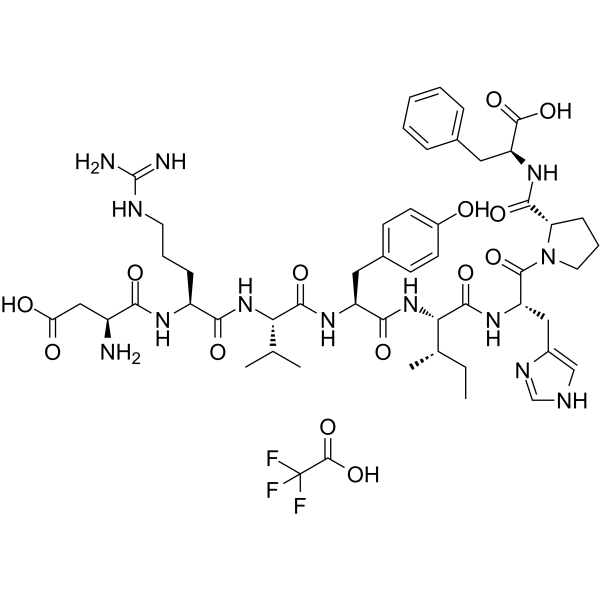Angiotensin II human TFA (Synonyms: Angiotensin II TFA; Ang II TFA; DRVYIHPF TFA) |
| رقم الكتالوجGC62844 |
أنجيوتنسين 2 البشري (أنجيوتنسين 2) TFA هو مضيق للأوعية وببتيد رئيسي نشط بيولوجيًا لنظام الرينين / الأنجيوتنسين
Products are for research use only. Not for human use. We do not sell to patients.

Cas No.: 2761969-44-0
Sample solution is provided at 25 µL, 10mM.
Angiotensin II human (Angiotensin II) TFA is a vasoconstrictor and a major bioactive peptide of the renin/angiotensin system. Angiotensin II human TFA plays a central role in regulating human blood pressure, which is mainly mediated by interactions between Angiotensin II and the G-protein-coupled receptors (GPCRs) Angiotensin II type 1 receptor (AT1R) and Angiotensin II type 2 receptor (AT2R). Angiotensin II human TFA stimulates sympathetic nervous stimulation, increases aldosterone biosynthesis and renal actions. Angiotensin II human TFA induces growth of vascular smooth muscle cells, increases collagen type I and III synthesis in fibroblasts, leading to thickening of the vascular wall and myocardium, and fibrosis. Angiotensin II human TFA also induces apoptosis. Angiotensin II human TFA induces capillary formation from endothelial cells via the LOX-1 dependent redox-sensitive pathway[1][2][3][4].
Most of the known actions of Angiotensin II (Ang II) human are mediated by AT1 receptors, the AT2 receptor contributes to the regulation of blood pressure and renal function[1]. Angiotensin II human raises blood pressure (BP) by a number of actions, the most important ones being vasoconstriction, sympathetic nervous stimulation, increased aldosterone biosynthesis and renal actions. Other Angiotensin II human actions include induction of growth, cell migration, and mitosis of vascular smooth muscle cells, increased synthesis of collagen type I and III in fibroblasts, leading to thickening of the vascular wall and myocardium, and fibrosis. These actions are mediated by type 1 Ang II receptors (AT1)[2]. Angiotensin II (1 nM) TFA induces the expression of LOX-1 and VEGF and enhances capillary formation from human coronary endothelial cells in Matrigel assay. Angiotensin II-mediated expression of LOX-1 and VEGF, capillary formation, intracellular reactive oxygen species generation, and phosphorylation of p38 as well as p44/42 mitogen-activated protein kinases, are suppressed by anti-LOX-1 antibody, nicotinamide-adenine dinucleotide phosphate oxidase inhibitor apocynin and the Ang II type 1 receptor blocker Losartan, but not by the Ang II type 2 receptor blocker PD123319[3].
Angiotensin II human (5 mL of 1 nM; intraperitoneal injection; 200-250 g Sprague-Dawley rats) TFA induces a significant neutrophil recruitment that was maximal at 4 hours and had resolved by 24 hours[4].To distinguish the AT1 receptor population that is critical for the pathogenesis of hypertension, osmotic minipumps are implanted s.c. into each animal to infuse Angiotensin II human (1000 ng/kg/min) acetate continuously for 4 weeks. Angiotensin II human acetate causes hypertension by activating AT1 receptors in the kidney promoting sodium reabsorption[5].
[1]. de Gasparo M, et al. International union of pharmacology. XXIII. The angiotensin II receptors. Pharmacol Rev. 2000 Sep;52(3):415-72.
[2]. Fyhrquist F, et al. Role of angiotensin II in blood pressure regulation and in the pathophysiology of cardiovascular disorders. J Hum Hypertens. 1995 Nov;9 Suppl 5:S19-24.
[3]. Hu C, et al. Angiotensin II induces capillary formation from endothelial cells via the LOX-1 dependent redox-sensitive pathway. Hypertension. 2007;50(5):952-957.
[4]. Nabah YN, et al. Angiotensin II induces neutrophil accumulation in vivo through generation and release of CXC chemokines. Circulation. 2004;110(23):3581-3586.
[5]. Crowley SD, et al. Angiotensin II causes hypertension and cardiac hypertrophy through its receptors in the kidney. Proc Natl Acad Sci U S A. 2006 Nov 21;103(47):17985-90.
Average Rating: 5 (Based on Reviews and 30 reference(s) in Google Scholar.)
GLPBIO products are for RESEARCH USE ONLY. Please make sure your review or question is research based.
Required fields are marked with *




















